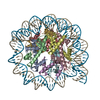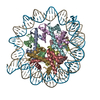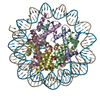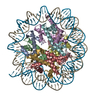+ Open data
Open data
- Basic information
Basic information
| Entry | Database: PDB / ID: 7dbh | |||||||||||||||||||||||||||||||||||||||
|---|---|---|---|---|---|---|---|---|---|---|---|---|---|---|---|---|---|---|---|---|---|---|---|---|---|---|---|---|---|---|---|---|---|---|---|---|---|---|---|---|
| Title | The mouse nucleosome structure containing H3mm18 | |||||||||||||||||||||||||||||||||||||||
 Components Components |
| |||||||||||||||||||||||||||||||||||||||
 Keywords Keywords | DNA BINDING PROTEIN / complex / chromatin / nucleosome / DNA BINDING PROTEIN-DNA complex | |||||||||||||||||||||||||||||||||||||||
| Function / homology |  Function and homology information Function and homology informationDeposition of new CENPA-containing nucleosomes at the centromere / Inhibition of DNA recombination at telomere / SUMOylation of chromatin organization proteins / DNA Damage/Telomere Stress Induced Senescence / G2/M DNA damage checkpoint / HDMs demethylate histones / Regulation of endogenous retroelements by KRAB-ZFP proteins / Condensation of Prophase Chromosomes / Nonhomologous End-Joining (NHEJ) / Metalloprotease DUBs ...Deposition of new CENPA-containing nucleosomes at the centromere / Inhibition of DNA recombination at telomere / SUMOylation of chromatin organization proteins / DNA Damage/Telomere Stress Induced Senescence / G2/M DNA damage checkpoint / HDMs demethylate histones / Regulation of endogenous retroelements by KRAB-ZFP proteins / Condensation of Prophase Chromosomes / Nonhomologous End-Joining (NHEJ) / Metalloprotease DUBs / Recognition and association of DNA glycosylase with site containing an affected purine / Cleavage of the damaged purine / HDACs deacetylate histones / PRC2 methylates histones and DNA / UCH proteinases / Processing of DNA double-strand break ends / HATs acetylate histones / MLL4 and MLL3 complexes regulate expression of PPARG target genes in adipogenesis and hepatic steatosis / Recruitment and ATM-mediated phosphorylation of repair and signaling proteins at DNA double strand breaks / PKMTs methylate histone lysines / RUNX1 regulates genes involved in megakaryocyte differentiation and platelet function / RMTs methylate histone arginines / Estrogen-dependent gene expression / Ub-specific processing proteases / protein localization to CENP-A containing chromatin / CENP-A containing nucleosome / structural constituent of chromatin / nucleosome / nucleosome assembly / chromatin organization / protein heterodimerization activity / DNA binding / nucleoplasm / nucleus Similarity search - Function | |||||||||||||||||||||||||||||||||||||||
| Biological species |  | |||||||||||||||||||||||||||||||||||||||
| Method | ELECTRON MICROSCOPY / single particle reconstruction / cryo EM / Resolution: 3.6 Å | |||||||||||||||||||||||||||||||||||||||
 Authors Authors | Hirai, S. / Takizawa, Y. / Kujirai, T. / Kurumizaka, H. | |||||||||||||||||||||||||||||||||||||||
| Funding support |  Japan, 12items Japan, 12items
| |||||||||||||||||||||||||||||||||||||||
 Citation Citation |  Journal: Nucleic Acids Res / Year: 2022 Journal: Nucleic Acids Res / Year: 2022Title: Unusual nucleosome formation and transcriptome influence by the histone H3mm18 variant. Authors: Seiya Hirai / Kosuke Tomimatsu / Atsuko Miyawaki-Kuwakado / Yoshimasa Takizawa / Tetsuro Komatsu / Taro Tachibana / Yutaro Fukushima / Yasuko Takeda / Lumi Negishi / Tomoya Kujirai / Masako ...Authors: Seiya Hirai / Kosuke Tomimatsu / Atsuko Miyawaki-Kuwakado / Yoshimasa Takizawa / Tetsuro Komatsu / Taro Tachibana / Yutaro Fukushima / Yasuko Takeda / Lumi Negishi / Tomoya Kujirai / Masako Koyama / Yasuyuki Ohkawa / Hitoshi Kurumizaka /  Abstract: Histone H3mm18 is a non-allelic H3 variant expressed in skeletal muscle and brain in mice. However, its function has remained enigmatic. We found that H3mm18 is incorporated into chromatin in cells ...Histone H3mm18 is a non-allelic H3 variant expressed in skeletal muscle and brain in mice. However, its function has remained enigmatic. We found that H3mm18 is incorporated into chromatin in cells with low efficiency, as compared to H3.3. We determined the structures of the nucleosome core particle (NCP) containing H3mm18 by cryo-electron microscopy, which revealed that the entry/exit DNA regions are drastically disordered in the H3mm18 NCP. Consistently, the H3mm18 NCP is substantially unstable in vitro. The forced expression of H3mm18 in mouse myoblast C2C12 cells markedly suppressed muscle differentiation. A transcriptome analysis revealed that the forced expression of H3mm18 affected the expression of multiple genes, and suppressed a group of genes involved in muscle development. These results suggest a novel gene expression regulation system in which the chromatin landscape is altered by the formation of unusual nucleosomes with a histone variant, H3mm18, and provide important insight into understanding transcription regulation by chromatin. | |||||||||||||||||||||||||||||||||||||||
| History |
|
- Structure visualization
Structure visualization
| Movie |
 Movie viewer Movie viewer |
|---|---|
| Structure viewer | Molecule:  Molmil Molmil Jmol/JSmol Jmol/JSmol |
- Downloads & links
Downloads & links
- Download
Download
| PDBx/mmCIF format |  7dbh.cif.gz 7dbh.cif.gz | 256 KB | Display |  PDBx/mmCIF format PDBx/mmCIF format |
|---|---|---|---|---|
| PDB format |  pdb7dbh.ent.gz pdb7dbh.ent.gz | 189.4 KB | Display |  PDB format PDB format |
| PDBx/mmJSON format |  7dbh.json.gz 7dbh.json.gz | Tree view |  PDBx/mmJSON format PDBx/mmJSON format | |
| Others |  Other downloads Other downloads |
-Validation report
| Summary document |  7dbh_validation.pdf.gz 7dbh_validation.pdf.gz | 783.1 KB | Display |  wwPDB validaton report wwPDB validaton report |
|---|---|---|---|---|
| Full document |  7dbh_full_validation.pdf.gz 7dbh_full_validation.pdf.gz | 799.6 KB | Display | |
| Data in XML |  7dbh_validation.xml.gz 7dbh_validation.xml.gz | 31.6 KB | Display | |
| Data in CIF |  7dbh_validation.cif.gz 7dbh_validation.cif.gz | 49.8 KB | Display | |
| Arichive directory |  https://data.pdbj.org/pub/pdb/validation_reports/db/7dbh https://data.pdbj.org/pub/pdb/validation_reports/db/7dbh ftp://data.pdbj.org/pub/pdb/validation_reports/db/7dbh ftp://data.pdbj.org/pub/pdb/validation_reports/db/7dbh | HTTPS FTP |
-Related structure data
| Related structure data |  30631MC  7vbmC M: map data used to model this data C: citing same article ( |
|---|---|
| Similar structure data |
- Links
Links
- Assembly
Assembly
| Deposited unit | 
|
|---|---|
| 1 |
|
- Components
Components
-Protein , 4 types, 8 molecules AEBFCGDH
| #1: Protein | Mass: 15350.842 Da / Num. of mol.: 2 Source method: isolated from a genetically manipulated source Source: (gene. exp.)   #2: Protein | Mass: 11676.703 Da / Num. of mol.: 2 Source method: isolated from a genetically manipulated source Source: (gene. exp.)  Gene: Hist1h4a, Hist1h4b, H4-53, Hist1h4c, H4-12, Hist1h4d, Hist1h4f, Hist1h4h, Hist1h4i, Hist1h4j, Hist1h4k, Hist1h4m, Hist2h4a, Hist2h4, Hist4h4 Production host:  #3: Protein | Mass: 14447.825 Da / Num. of mol.: 2 Source method: isolated from a genetically manipulated source Source: (gene. exp.)   #4: Protein | Mass: 14307.559 Da / Num. of mol.: 2 Source method: isolated from a genetically manipulated source Source: (gene. exp.)   |
|---|
-DNA chain , 2 types, 2 molecules IJ
| #5: DNA chain | Mass: 44520.383 Da / Num. of mol.: 1 Source method: isolated from a genetically manipulated source Source: (gene. exp.)   |
|---|---|
| #6: DNA chain | Mass: 44991.660 Da / Num. of mol.: 1 Source method: isolated from a genetically manipulated source Source: (gene. exp.)   |
-Experimental details
-Experiment
| Experiment | Method: ELECTRON MICROSCOPY |
|---|---|
| EM experiment | Aggregation state: PARTICLE / 3D reconstruction method: single particle reconstruction |
- Sample preparation
Sample preparation
| Component | Name: The mouse nucleosome containing H3mm18 / Type: COMPLEX / Entity ID: all / Source: RECOMBINANT |
|---|---|
| Source (natural) | Organism:  |
| Source (recombinant) | Organism:  |
| Buffer solution | pH: 7.5 |
| Specimen | Embedding applied: NO / Shadowing applied: NO / Staining applied: NO / Vitrification applied: YES |
| Vitrification | Cryogen name: ETHANE |
- Electron microscopy imaging
Electron microscopy imaging
| Experimental equipment |  Model: Titan Krios / Image courtesy: FEI Company |
|---|---|
| Microscopy | Model: TFS KRIOS |
| Electron gun | Electron source:  FIELD EMISSION GUN / Accelerating voltage: 300 kV / Illumination mode: FLOOD BEAM FIELD EMISSION GUN / Accelerating voltage: 300 kV / Illumination mode: FLOOD BEAM |
| Electron lens | Mode: BRIGHT FIELD |
| Image recording | Electron dose: 56.6 e/Å2 / Film or detector model: GATAN K3 (6k x 4k) |
- Processing
Processing
| CTF correction | Type: PHASE FLIPPING AND AMPLITUDE CORRECTION |
|---|---|
| 3D reconstruction | Resolution: 3.6 Å / Resolution method: FSC 0.143 CUT-OFF / Num. of particles: 274546 / Symmetry type: POINT |
 Movie
Movie Controller
Controller














 PDBj
PDBj







































